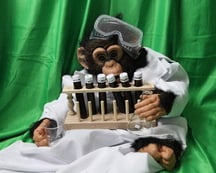
I have a pretty regimented routine of powdered caffeine usage. A lovely fellow I know asked me about it recently. Occasionally people do. And I thought, I should just tell everybody.
To do that, I’ll first have to summarise something that was once online and I can’t find these days: agonistic versus antagonistic usage of stimulants. It’s simpler than it sounds.
And I’ll describe the eight-week cycle I’m on to manage my tolerance. Caffeine is an addictive drug that builds high tolerance. Most people ignore that, build their tolerance and then don’t get much benefit from it afterward. That problem can be fixed.
Agonistic Vs Antagonistic
The short version goes: you can take caffeine when you’re tired at night to stay up longer. You won’t feel as tired, you’ll be able to focus better than when you’re exhausted, the reduced sleep will be mostly okay until you can catch up later.
This is called “antagonistic” use of a stimulant. Your body is trying to do something (go to sleep) and you’re working against it. The caffeine lets you have more hours of nearly-as-good-as-well-rested time when usually you’d have exhausted time.
You can also take caffeine bright and early in the morning, to help yourself focus better than you usually would. It can make you more energetic, and to some extent smarter, than you otherwise would be. By the time you’d be going to bed, the caffeine is wearing off. So you’re smarter during the day, but you don’t normally get an extended amount of daytime, just extra energy and focus during normal waking hours.
This is called “agonistic” usage, the opposite of antagonistic. Your body is doing something (being awake in the morning) and you’re increasing or exaggerating it.
Stimulants take a toll on your body. “Coffee is the theft of time, which by rights belongs to your future self” says Terry Pratchett. That’s roughly true. You can move your energy and focus around to when it’s most valuable to you. But you can’t get significantly more. One way or another, you’ll need to pay the cost of it.
There’s a natural curve to your attention and focus. You can’t just burn energy all the time. If you use a stimulant agonistically, you’re trying to increase that curve – more focus when you’re focused, and even less focus during your down-times. If you use it antagonistically, you’re trying to flatten that curve – extra focus during down-times, at the cost of being more tired during your higher-focus times.
You shouldn’t mix agonistic and antagonistic usage. I’d recommend separating them by at least a few days if you can. Coffee can make you brighter and perkier. It can make you stay up late at night. But if you try to combine the two, you’ll normally have a bad time. The increased body load is real. You’re also messing up those curves. You can’t tell your body “you don’t get rest” for very long. At most, you can change when your body takes its rest, and how much you tire yourself out by hard focus and vibrant energy.
My Daily Routine
I’m an agonistic caffeine user. I’m a computer programmer, and mostly I need to be smarter than I could be naturally. If that’s only for a limited number of hours per day, I’m fine with that. My un-aided number of hours of enhanced intelligence is zero. If I can bring that up to, say, three, that’s a huge benefit to me.
You could do the same thing with antagonistic usage – have quieter, longer days at lower focus. I can think of jobs where that’s useful, or it might just be a thing you want for yourself. I assume it would work very similarly. But it’s not something I’ve done for myself, so I won’t tell you about it.
Since I’m an agonistic user I have my caffeine early in the morning, usually around 300mg. I mix it into tea or coffee since caffeine is really bitter. Putting it in milk or orange juice, for instance, tastes terrible.
I’m careful to avoid having caffeine later in the day. Remember: you shouldn’t mix agonistic and antagonistic, so you have to be somewhat disciplined about that. It’s not a 100% always rule, but having a lot of caffeine later in the day will throw off my rhythm for a few days.
I tend to have caffeine Monday through Friday and then skip Saturday/Sunday. Not only do I do professional work M-F, on Saturday and Sunday I’m often doing things with my wife and kids, not sitting and programming. The extra no-caffeine time makes it easier to catch up on sleep and not build tolerance too fast.
Tolerance Resets
There’s a problem with the obvious “just do that daily” method. You build up significant tolerance to caffeine, and eventually it’s a lot less effective at making you smarter. There’s a related problem when you’re too tired, whether from hard labour or skipped sleep. If your body doesn’t have the extra “oomph,” the caffeine will mostly feel like a non-event.
In both cases, the first thing to do is to stop taking caffeine for a bit. Tolerance builds regularly, so I have a relatively simple pattern of six weeks on and 1.5-2 weeks off. I’m going to a work event in Amsterdam as I write this. It throws off my schedule, so I’m extending the caffeine break to more like 2.5 weeks. But I try for minimum 1.5 weeks. I don’t avoid caffeine 100%. I usually have a cup of Earl Grey in the morning. But compared to my normal, that’s still a great way to reset tolerance.
I’ve tried shorter reset breaks. Some sources will claim your body can reset in at little as 2-4 days. My experience has been that to reset both physical tolerance and “body habits,” it really does take over a week. Sometimes 1.5 weeks is enough for me, sometimes it isn’t, so I try to make it to 2 weeks. That also makes for a calendar-friendly cadence of six weeks on, two weeks off.
I’ve tried resets without even the tea. For me it hasn’t been any more helpful. And I’ve tried breaks of a month or more. That is slightly more helpful, but not enough, for me, to be worth the extra reset time.
I used to get caffeine headaches when doing the no-caffeine weeks. I still get the occasional fairly mild one. But mostly the combination of a short – six weeks – time building tolerance with practice and repetition has been enough to get rid of them.
If it seems like your tolerance is getting high, also make sure you’re getting enough sleep. You won’t stay away significantly more hours this way, but you may have a higher-intensity routine anyway. Sometimes you just need more sleep to make up for more focus. The “hey, nothing happened” feeling of high tolerance is hard for me to tell apart from the “hey, nothing happened” when I’m just too tired.
Doctors and Medicating
Some folks with ADHD in the audience have been doing some mental math. ADHD is commonly treated with very caffeine-like stimulants (e.g. Ritalin, Adderall). It’s not unknown for ADHD folks to self-medicate in this way.
Caffeine is quite easy to get compared to prescription-only ADHD medications. It’s also quite cheap. $20 or so of powdered caffeine can last multiple years, and it may well expire before you run out.
If you can get a diagnosis it’s probably worth getting the real stuff. Caffeine builds tolerance much faster than prescription ADHD medication, which requires much stronger discipline in how you take it – including during times when you’re off your meds to reset your tolerance. The prescription medication is just better.
That “if you can get” last paragraph is doing a lot of work. Many folks have a hard time dealing with doctors for all sorts of good reasons. If that’s you, or if you have a long delay before you can see a doctor, I’d say go for caffeine. You’ll know more about how you respond to it by the time you can get a diagnosis. The presciption medication will still be a step up.
You may well want to stop taking caffeine before you actually see the doctor, though. A distressing number of doctors treat “I have this mostly under control with a Rube Goldberg machine of bad coping methods” as being the same thing as “fine, really”. And they often respond very poorly to you explaining complicated situations or treatments. Instead, just have a reset period (again, around 1.5-2 weeks) before you see them and let them diagnose you while untreated. If no good comes of it, you can always start back on your normal caffeine cycle. You and I both know that we’re talking about intense use of an addictive stimulant. But like alcohol, it has many years of precedent and we pretend that makes it fine.


Comments